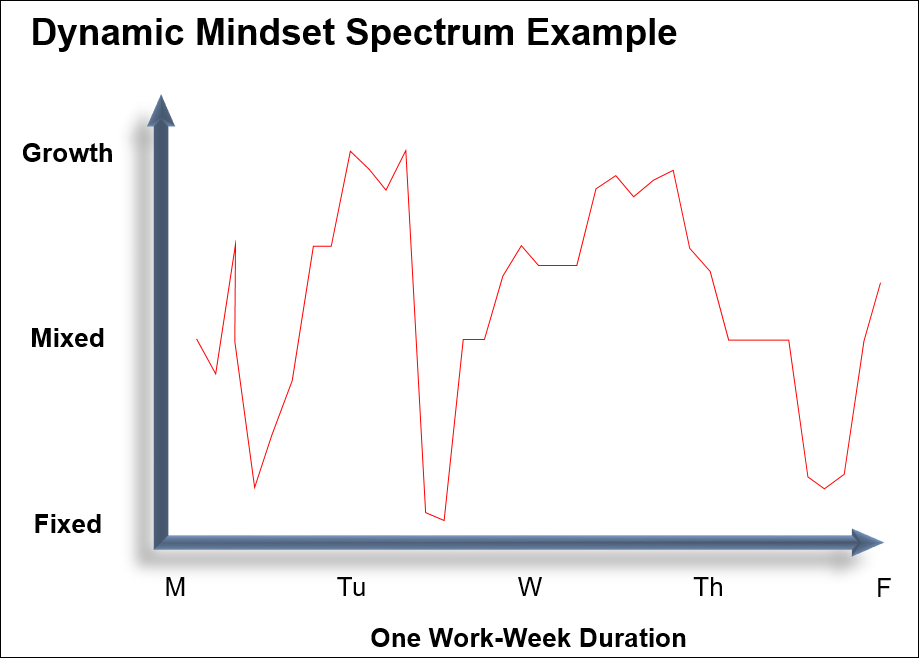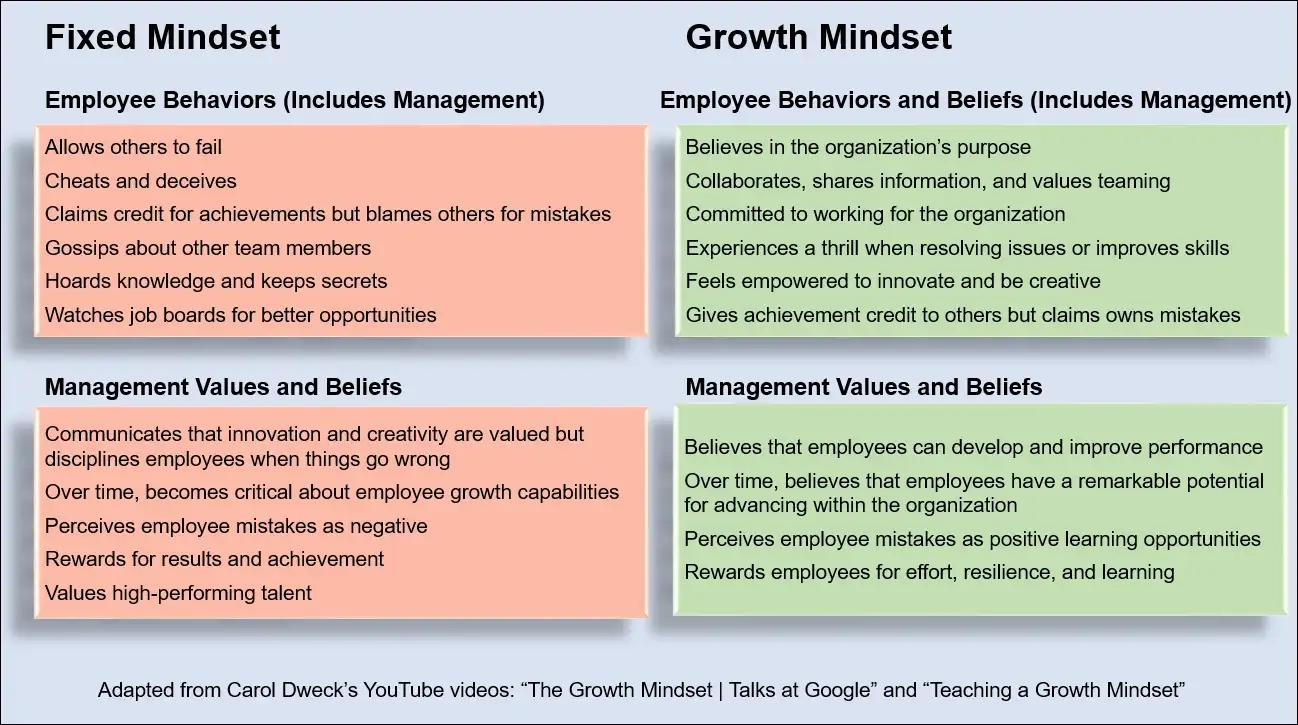Create a culture that means business™
Email address
When I worked in talent development departments, managers periodically would request team building solutions. What they really wanted was to unify and engage their teams but didn’t know how. In my blog, “Should You Start with Team Building to Increase Engagement?”, I encourage HR professionals to diagnose team engagement by searching for an imbalance in five areas. The first is psychological safety, discussed in my last blog. For this blog, I explain the second area, growth mindset.
Statements that reveal mindset influence
In the table below, I’ve listed six paraphrased statements from actual professionals whom I’ve interviewed as part of my consulting practice. As you read each one, decide if you agree, somewhat agree, somewhat disagree, or disagree.
1. When people achieve major accomplishments, it is not a good idea to tell them how smart they are.
2. Hiring candidates who are fully qualified for jobs makes a company stronger than hiring candidates who are partially qualified.
3. When I experience a setback, I may feel discouraged or disappointed before I try again.
4. Some professionals are natural leaders.
5. The people I work with have a lot of potential at improving their performance.
6. Although I may not admit it, I sometimes resent a peer’s promotion when I’m more qualified.
Each statement reflects a mindset. The even numbered statements illustrate a fixed mindset while the odd numbered ones illustrate a growth mindset. If you agreed with some of each type, you’re not alone. People tend to have a mix of both mindsets.
Raising your team’s awareness about fixed and growth mindsets can help them shift their thinking towards a growth mindset. According to Hilary Scarlett, author of “Neuroscience for Organizational Change” and Carol Dweck, author of “Mindset”, doing so could strengthen team engagement, improve the team’s health and increase performance.
Fixed and growth mindsets
Don’t underestimate the definitions of fixed and growth mindsets. Intellectually, the concepts are easy to grasp but harder to recognize when you are thinking from one mindset or the other.
Consider the two mindsets from this perspective: Mindsets are a set of conscious or unconscious beliefs that affect how you think about your abilities, how you behave and how you affect those around you. You can reject having a fixed mindset but unintentionally interpret a set of circumstances from a fixed mindset.
From a fixed mindset, you think and act as if you cannot further develop your IQ, EQ, traits, skills, abilities and competencies. Believing that these are fixed in adulthood leads to thoughts such as:
- “I can’t draw.”
- “Michael Jordan is a gifted athlete.”
- “I’m not as smart as people believe.”
- “Failing is harmful.”
Fixed mindset behaviors include avoiding tasks outside of your comfort zone, laughing when others appear foolish and even spreading rumors to make a team member look bad.
From a growth mindset, you think and act as if you can develop and improve your IQ, EQ, traits, abilities and competencies. Believing that adults can continue to grow leads to thoughts such as:
- “Taking an art class can help me learn to draw.”
- “Michael Jordan’s dedication to practice and learning led to his remarkable achievements.”
- “I still can improve how smart I am.”
- “Failing is a fantastic way to learn and improve.”
Growth mindset behaviors might include working diligently to solve a problem, asking your manager for stretch assignments, seeking peers for help and giving team members credit for their contributions.
You need to know about the mindset dynamic spectrum
As circumstances change, so might your mindset.
- You have a growth mindset when some peers critique your work but a fixed one when other peers do the same.
- A setback triggers a fixed reaction while another triggers a growth reaction.
- You’re open to develop certain skills but not as open with other skills.
For me, I welcome challenges that improve my leadership views; I recognize that I can learn from colleagues who expose flaws in my thinking. However, when it comes to learning Spanish, I’m reluctant to try.
During a given week, your mindset can often shift. I illustrate this in the chart below. When circumstances and environments change, your mindset may change as well.

Rather than stereotyping others as having either a fixed or growth mindset, think of them as having a mix of the two. Some may have a dominate mindset, but at times, their mindset might shift towards the other mindset.
Determine your triggers
To help you manage your mindset, try discovering what triggers a fixed or growth mindset.
- When you’re tired, do you tend to revert to a fixed mindset?
- If someone receives recognition as being highly skilled in your specialty, are you envious or do you want that person to mentor you?
- If a subordinate makes a mistake, do you penalize the person or view the mistake as a positive learning experience?
- If a peer criticizes you, are you defensive, or do you try to learn from the critique?
- When a teammate struggles with a problem, do you take time away from your work to volunteer your help, or do you question that person’s capabilities?
- When a project goes wrong, do you blame your teammates, or do you focus your efforts to correct the problem?
Companies with fixed and growth mindsets
In her research, Dweck found that companies could have fixed or growth mindsets. Moreover, her research reveals that a company’s mindset affects the likelihood that employees would behave in particular ways. For example, in an article by Love, she references a Dweck article that states how a growth-mindset company has employees who are 47% likelier to perceive colleagues as trustworthy and are 65% likelier to say that the company supports risk taking.
In her videos, Dweck also describe other mindset trends illustrated below:

What do mindsets have to do with teams and team engagement?
Rather than labeling companies as having one mindset or the other, think of companies as having micro-environments or sub-cultures that stimulate fixed or growth thinking. Team members are influenced by their team’s environment as well as other team environments that they interact within. This gives hope that within their team’s environment, team members can foster a growth mindset regardless if other team environments in the same company trend towards a fixed mindset.
As HR professionals, helping teams shift towards a growth mindset can improve employee engagement and productivity. As Scarlett explains, “One of the great things about mindset is how easily it can be changed…Just teaching people about the concept and the difference the two mindsets make, creates a difference to performance.”
Call to action
Learn as much as you can about fixed and growth mindsets by using the references below or by consulting experts. Try working with teams not only to raise their awareness but also to discover what triggers their thinking towards one mindset or the other. Training teams on mindsets could be a better alternative than only facilitating team building activities. Alternatively, you can design teambuilding around mindset awareness. The bottom line: the more you can shift your team towards a growth mindset, the more your team will be engaged and perform better.
References
- Blanchard’s blog: “Mindset Series: 1. Fixed vs Growth Mindset”
- Dweck’s video: “The Growth Mindset | Talks at Google”
- Crabtree’s article: “Global Productivity Hinges on Human Capital Development”
- Kouzes and Posner’s book: “The Leadership Challenge”
- Kruger’s article: “The Growth Mindset: Four Ingredients for Creating A High-Performance Culture”
- Love’s smart brief: “How Leaders Can Foster a Growth Mindset”
- Scarlett’s book: “Neuroscience for Organizational Change”
- Schneider’s Inc. article: “Google Spent Years Studying Effective Bosses”
- Zhuo’s article: “Taking Feedback Impersonally”
Are you looking for an effective way to engage your employees? Access Achievers’ report on “Building a Business Case for Social Recognition” to get started.


